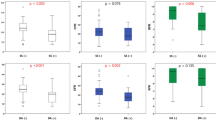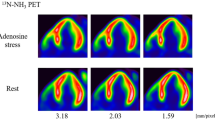Abstract
Purpose
The relationship between myocardial blood flow (MBF) and stenosis severity has been determined previously using cyclotron-produced radiotracers such as 15O-H2O and 13N-ammonia. An attractive alternative to overcome the limitations related to the use of cyclotron might be to use the generator-produced 82Rb as a flow tracer. The current study was undertaken to investigate the relationship between MBF and coronary vasodilator reserve (CVR) as measured by 82Rb positron emission tomography (PET) and the percent diameter stenosis as defined by quantitative coronary arteriography.
Methods
We prospectively evaluated 22 individuals: 15 patients (60 ± 11 years of age) with angiographically documented coronary artery disease (CAD) and seven age-matched (56 ± 9 years) asymptomatic individuals without risk factors for CAD. Dynamic 82Rb PET was performed at rest and after dipyridamole vasodilation. MBF, CVR and an index of ‘minimal coronary resistance’ (MCR) were assessed in each of the three main coronary territories.
Results
Rest and stress MBF in regions subtended by vessels with less than 50% diameter stenosis was similar to that of the individuals with no risk factors for CAD. As a result, CVR was also similar in the two groups (1.9, interquartile [IQ] range from 1.7 to 2.7 vs. 2.2, IQ range from 2 to 3.4 respectively, p = 0.09). CVR successfully differentiated coronary lesions with stenosis severity 70% to 89% from those with 50% to 69% stenosis (1, IQ range from 1 to 1.3 vs. 1.7, IQ range from 1.4 to 2), respectively, p = 0.001. In addition, hyperaemic MBF (r 2 = 0.74, p < 0.001), CVR (r 2 = 0.69, p < 0.001) and MCR (r 2 = 0.78, p < 0.001) measurements were inversely and non-linearly correlated to the percent diameter stenosis on angiography.
Conclusion
MBF and CVR are inversely and non-linearly correlated to stenosis severity. Quantitative 82Rb PET can be a clinically useful tool for an accurate functional assessment of CAD.





Similar content being viewed by others
References
Uren NG, Crake T, Lefroy DC, de Silva R, Davies GJ, Maseri A. Reduced coronary vasodilator function in infarcted and normal myocardium after myocardial infarction. N Engl J Med 1994;331(4):222–7.
Yoshinaga K, Katoh C, Noriyasu K, Iwado Y, Furuyama H, Ito Y, et al. Reduction of coronary flow reserve in areas with and without ischemia on stress perfusion imaging in patients with coronary artery disease: a study using oxygen 15-labeled water PET. J Nucl Cardiol 2003;3:275–83.
Uren NG, Melin JA, De Bruyne B, Wijns W, Baudhuin T, Camici PG. Relation between myocardial blood flow and the severity of coronary-artery stenosis. N Engl J Med 1994;330(25):1782–8.
Di Carli M, Czernin J, Hoh CK, Gerbaudo VH, Brunken RC, Huang SC, et al. Relation among stenosis severity, myocardial blood flow, and flow reserve in patients with coronary artery disease. Circulation 1995;91:1944–51.
Beanlads RS, Muzik O, Melon P, Sutor R, Sawada S, Muller D, et al. Noninvasive quantification of regional myocardial flow reserve in patients with coronary atherosclerosis using nitrogen-13 ammonia positron emission tomography. Determination of extent of altered vascular reactivity. J Am Coll Cardiol 1995;26(6):1465–75.
Gould KL. Absolute myocardial perfusion and coronary flow reserve. Coronary artery stenosis and reversing atherosclerosis. New York, NY: Arnold; 1999. p. 247–73.
Coxson PG, Huesman RH, Borland L. Consequences of using a simplified kinetic model for dynamic PET data. J Nucl Med 1997;38:660–7.
Herrero P, Markham J, Shelton ME, Bergmann SR. Implementation and evaluation of a two-compartment model for quantification of myocardial perfusion with rubidium-82 and positron emission tomography. Circ Res 1992;70:496–507.
Lin JW, Sciacca RR, Chou RL, Laine FA, Bergmann SR. Quantification of myocardial perfusion in human subjects using 82Rb and wavelet-based noise reduction. J Nucl Med 2001;42:201–8.
Lin JW, Laine FA, Akinboboye O, Bergmann SR. Use of wavelet transforms in analysis of time–activity data from cardiac PET. J Nucl Med 2001;42:194–201.
El Fakhri G, Sitek A, Guérin B, Kijewski MF, Di Carli MF, Moore SC. Quantitative dynamic cardiac 82Rb PET using generalized factor and compartment analyses. J Nucl Med 2005;46(8):1264–71.
Marshall RC, Taylor SE, Powers-Risius P, Reutter BW, Kuruc A, Coxson PG, et al. Kinetic analysis of rubidium and thallium as deposited myocardial blood flow tracers in isolated rabbit heart. Am J Physiol 1997;272:H1480–1490.
El Fakhri G, Guérin B, Sitek A, Currilova Z, Anagnostopoulos C, et al. Absolute myocardial blood flow quantitation in Rb-82 Cardiac PET using generalized factor and compartment analysis: a reproducibility study [abstract]. Eur J Nucl Med Mol Imaging 2006;33(2):S217.
van der Zwet PM, Reiber JH. A new approach for the quantification of complex lesion morphology: the gradient field transform: basic principles and validation results. J Am Coll Cardiol 1994;24:216–24.
Gould LK, Lipscomb K, Hamilton GW. Physiologic basis for assessing critical coronary stenosis. Instantaneous flow response and regional distribution during coronary hyperemia as measures of coronary flow reserve. Am J Cardiol 1974;33(1):87–94.
Goldstein RA, Kirkeeide RL, Demer LL, Merhige M, Nishikawa A, Smalling RW, et al. Relation between geometric dimensions of coronary artery stenoses and myocardial perfusion reserve in man. J Clin Invest 1987;79:1473–8.
Pitkänen OP, Nuutila P, Raitakari OT, Rönnemaa T, Koskinen PJ, Iida H, et al. Coronary flow reserve is reduced in young men with IDDM. Diabetes 1998;47(2):248–54.
Laine H, Raitakari OT, Niinikoski H, Pitkänen OP, Iida H, Viikari J, et al. Early impairment of coronary flow reserve in young men with borderline hypertension. J Am Coll Cardiol 1998;32(1):147–53.
Yokoyama I, Ohtake T, Momomura S, Nishikawa J, Sasaki Y, Omata M. Reduced coronary flow reserve in hypercholesterolemic patients without overt coronary stenosis. Circulation 1996;94:3232–8.
Bache RJ, Cobb FR. Effect of maximal coronary vasodilation on transmural myocardial perfusion during tachycardia in the awake dog. Circ Res 1977;41:648–53.
McGinn AL, White CW, Wilson RF. Interstudy variability of coronary flow reserve: influence of heart rate, arterial blood pressure, and ventricular preload. Circulation 1990;81:1319–30.
Rossen JD, Winniford MD. Effect of increases in heart rate and arterial pressure on coronary flow reserve in humans. J Am Coll Cardiol 1993;21:343–8.
Czernin J, Müller P, Chan S, Brunken RC, Porenta G, Krivokapich J, et al. Influence of age and hemodynamics on myocardial blood flow and flow reserve. Circulation 1993;88:62–9.
Mosher P, Ross J Jr, McFate PA, Shaw RF. Control of coronary blood flow by an autoregulatory mechanism. Circ Res 1964;14:250–6.
Marzilli M, Goldstein S, Sabbah HN, Lee T, Stein PD. Modulating effect of regional myocardial performance on local myocardial perfusion in the dog. Circ Res 1979;45:634–41.
Shellbert HR, Prior JO. Positron emission tomography. In: Fuster V, et al, editor. Hurst’s, the heart. New York, NY: McGraw-Hill; 2004. p. 557–693.
Fakhri G, Mekkaoui C, Sitek A, Dione DP, Carson RE, Brennan M, et al. Experimental validation using radiolabeled microspheres of absolute quantitation of regional myocardial blood flow using dynamic rubidium 82 positron emission tomography [abstract]. J Nucl Med 2007;48(2):54.
Acknowledgements
We thank Martha Coughlan and Lisa Cantagallo, research coordinators, and also Jon Hainer, IT consultant in the Nuclear Medicine/PET division, Department of Radiology, Brigham and Women’s Hospital, for their assistance during this project.
Author information
Authors and Affiliations
Corresponding author
Rights and permissions
About this article
Cite this article
Anagnostopoulos, C., Almonacid, A., El Fakhri, G. et al. Quantitative relationship between coronary vasodilator reserve assessed by 82Rb PET imaging and coronary artery stenosis severity. Eur J Nucl Med Mol Imaging 35, 1593–1601 (2008). https://doi.org/10.1007/s00259-008-0793-2
Received:
Accepted:
Published:
Issue Date:
DOI: https://doi.org/10.1007/s00259-008-0793-2




